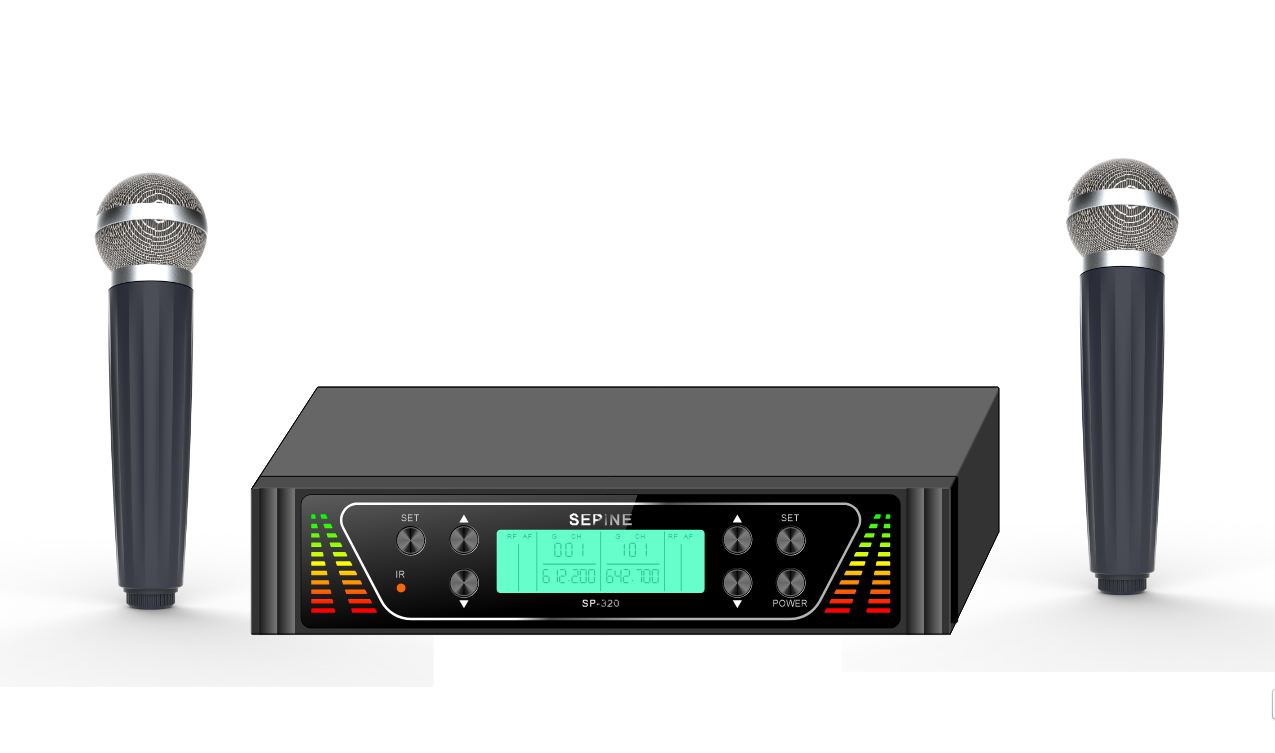The Benefits of Double Conversion in UHF Wireless Microphones

Exploring Double Conversion in UHF Wireless Microphones
Wireless microphones have revolutionized the way audio professionals, musicians, and sound engineers capture and transmit sound. Among the various advancements in wireless microphone technology, double conversion stands out as a game-changer. By employing a two-step conversion process, double conversion enhances signal quality and range while reducing interference and dropout issues.
With double conversion, UHF wireless microphones achieve improved signal quality by minimizing loss and distortion. This ensures that the audio remains clear and pristine throughout the transmission process. Additionally, this technology extends the range of operation for UHF wireless microphones, allowing performers to move freely without worrying about signal dropouts or loss of audio quality.
One of the key advantages of double conversion is its ability to reduce interference. By utilizing advanced filtering techniques, unwanted signals are eliminated, resulting in a clean and uninterrupted audio transmission. This is particularly beneficial in environments with multiple wireless devices or crowded RF spectrums.
Furthermore, double conversion effectively eliminates dropout issues commonly experienced with wireless microphones. The two-step conversion process ensures a seamless performance without any interruptions or sudden audio loss. This reliability is crucial for live performances, events, and professional recordings where every moment counts.
In addition to improving signal quality and reducing interference, double conversion also enhances audio clarity and fidelity. It reduces background noise, distortion, and unwanted artifacts that can compromise the overall listening experience. With dual conversion technology, UHF wireless microphones accurately capture and reproduce the nuances of sound with exceptional precision.
Another significant advantage of double conversion is its efficient prevention of feedback issues. Feedback occurs when an audio system picks up its own output signal through a microphone or speaker. This can result in an unpleasant screeching or howling sound that disrupts performances or presentations. However, with advanced feedback suppression algorithms employed in double conversion systems, this problem is effectively mitigated.
Moreover, double conversion provides greater flexibility in frequency selection, making it suitable for professional applications. This allows users to find and utilize the optimal frequency range, ensuring compatibility with other wireless systems and minimizing interference. The versatility of double conversion technology makes it an ideal choice for audio professionals, musicians, and sound engineers who require reliable and high-performance wireless microphones.
Amplifying Signal Quality and Range
Wireless microphones are relied upon to deliver clear and high-quality audio in various professional settings. Double conversion technology plays a crucial role in enhancing the signal quality of UHF wireless microphones, ensuring optimal performance.
By utilizing a two-step conversion process, double conversion minimizes signal loss and distortion, resulting in improved signal quality. This technology effectively preserves the integrity of the audio signal throughout the transmission process, delivering clear and pristine sound reproduction. Whether it's capturing vocals or musical instruments, UHF wireless microphones with double conversion provide exceptional clarity and fidelity.
In addition to improving signal quality, double conversion also extends the range of operation for UHF wireless microphones. Performers and audio professionals can move freely without worrying about signal dropouts or loss of audio quality. This extended range allows for greater flexibility on stage or during live events, ensuring that every word spoken or note played is captured accurately.
With dual conversion technology, UHF wireless microphones offer enhanced audio quality that meets the demands of professional applications. The two-step conversion process eliminates any potential degradation of the original sound source, resulting in pristine sound reproduction. Whether used in concerts, conferences, or broadcast environments, UHF wireless microphones with double conversion ensure that every detail is captured with exceptional clarity.
Reducing Interference and Dropout for Seamless Performance
Interference and dropout issues can significantly impact the performance of wireless microphones, leading to compromised audio quality. However, with the implementation of double conversion technology, UHF wireless microphones experience reduced interference and minimal dropout, ensuring a seamless and uninterrupted performance.
Double conversion technology effectively minimizes interference in UHF wireless microphones by employing advanced filtering techniques. Unwanted signals and noise are eliminated, allowing for a clean and uninterrupted audio transmission. This ensures that the desired sound is captured without any disturbance or signal interference. Whether it's a live concert or a corporate event, UHF wireless microphones with double conversion provide reliable and high-quality audio.
Moreover, by utilizing double conversion, UHF wireless microphones experience minimal dropout issues. Dropout refers to the sudden loss of audio signal during transmission. With dual conversion technology, the two-step conversion process enhances the stability of the wireless connection, reducing the chances of signal dropout. Performers can confidently move around on stage without worrying about sudden audio loss or interruption.
The combination of reduced interference and minimal dropout ensures a seamless performance for audio professionals, musicians, and sound engineers. It allows them to focus on their craft without being hindered by technical difficulties. The reliability provided by double conversion technology is particularly crucial in critical applications such as live performances, broadcasting, or professional recordings where every moment counts.
Enhancing Audio Clarity, Fidelity, and Feedback Prevention
When it comes to audio quality, double conversion technology in UHF wireless microphones excels in enhancing audio clarity, fidelity, and preventing feedback issues. This ensures a superior listening experience for both performers and audiences alike.
Double conversion technology significantly enhances the clarity of audio in UHF wireless microphones. It reduces background noise, distortion, and unwanted artifacts that can compromise the overall sound quality. By minimizing these audio imperfections, double conversion enables crystal clear sound reproduction. Whether it's capturing vocals or musical instruments, UHF wireless microphones with double conversion deliver a clean and crisp sound that faithfully represents the original source.
Moreover, with double conversion, UHF wireless microphones achieve improved audio fidelity. The two-step conversion process accurately captures and reproduces the nuances of the sound. This means that every subtle detail is faithfully conveyed to the audience, resulting in a high-quality listening experience. Musicians can rely on UHF wireless microphones with double conversion to accurately capture their performances with exceptional precision.
Efficient feedback prevention is another advantage of double conversion technology in UHF wireless microphones. Feedback occurs when an audio system picks up its own output signal through a microphone or speaker, resulting in an unpleasant screeching or howling sound. However, with advanced feedback suppression algorithms employed in double conversion systems, this problem is efficiently eliminated. Performers can confidently use UHF wireless microphones without worrying about disruptive feedback issues.
The combination of enhanced audio clarity, improved fidelity, and efficient feedback prevention makes double conversion technology a valuable asset for professionals who demand high-quality audio performance. Whether it's for live events, studio recordings, or broadcast applications, UHF wireless microphones equipped with double conversion provide reliable and pristine sound reproduction.
Applications and Flexibility in UHF Wireless Microphones
Double conversion technology in UHF wireless microphones is highly suitable for professional applications, catering to the needs of audio professionals, musicians, and sound engineers. Its reliability, stability, and performance make it an ideal choice for various industry applications.
In professional settings such as concerts, conferences, or live events, UHF wireless microphones with double conversion provide the necessary reliability required by audio professionals. The two-step conversion process ensures a stable and consistent signal transmission, minimizing the risk of dropouts or interruptions. This level of dependability is crucial when capturing important performances or delivering presentations with utmost clarity.
Furthermore, double conversion technology offers flexibility in frequency selection for UHF wireless microphones. Users can take advantage of this feature to find and utilize the optimal frequency range that suits their specific needs. This not only ensures compatibility with other wireless systems but also minimizes interference from surrounding devices operating on similar frequencies. The ability to adapt to different frequency environments makes UHF wireless microphones with double conversion versatile tools for various professional use cases.
Whether it's in the music industry, broadcasting sector, or corporate events, double conversion technology provides the necessary performance and flexibility demanded by professionals. Its ability to deliver reliable signal transmission and adaptability to different frequency ranges makes it an invaluable asset for those seeking high-quality audio solutions.
Harnessing the Power of Double Conversion
Double conversion in UHF wireless microphones offers a multitude of benefits for audio professionals, musicians, and sound engineers. By amplifying signal quality and range, reducing interference and dropout, enhancing audio clarity and fidelity, preventing feedback, and providing flexibility in frequency selection, double conversion ensures a superior and reliable performance.
Embrace the power of double conversion and experience the exceptional audio quality and seamless operation it brings to UHF wireless microphones. Whether you're an audio professional, musician, or sound engineer, incorporating double conversion technology into your setup will elevate your sound production to new heights. With its advanced features and capabilities, double conversion is the key to unlocking the full potential of UHF wireless microphones.
See Also
Unveiling the Advantages of D-PLL RF Frequency Lock in UHF Wireless Microphones
Unraveling the Advancements in Adjustable Frequency UHF Systems and Wireless Microphones
Discovering the Advantages of Wireless Microphones
In-Depth Analysis: UHF 2 Ch Wireless 2 x Microphone Set with XLR Balanced Output
Exploring the Top 10 Advantages of Wireless Microphones for Home Entertainment Audio Solutions
About US
Follow Us
Shenzhen Sepine Technology Co., Ltd. has been focusing on the research and development of in-car audio-visual entertainment and advertising players since 2003,with a main product line for passenger vehicles, including taxis, coaches, large vans, trains and trucks. Our products include displays,advertising players, rear-seat systems, and safety devices.
Address
Bldg4,Youshen Industrial Area,BaoanDistrict,Shenzhen,Guangdong,China
Contacts
+86 13410056292

